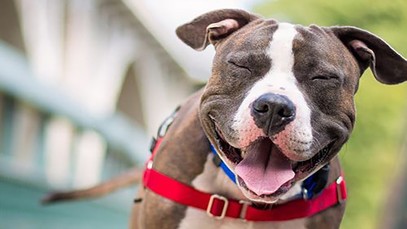
Somewhere along the way, the pit bull gained the reputation of being dangerous, unpredictable and certainly not good for families with kids. Many apartment buildings won’t even allow pit bulls and other dog breeds that have been deemed “too dangerous” to live there. Where did this stereotype come from, and is it even justified...?
The pit bull as a breed has been around for quite a long time - one theory says since the Norman conquest of 1066. Butchers would use dogs to help them subdue bulls, by biting the bull’s nose. This activity eventually became a spectator sport, where people would place bets on which dog could hold onto a riled-up bull’s nose the longest. And thus, the name “pit bull” was born.
This less-than-glamorous sport was eventually outlawed in the 19th century. Illegal dog fighting, however, gained popularity in the UK, and was brought to the United States by British immigrants at the time.
The pit bull breed wasn’t officially recognized by the American Kennel Club until 1936 because of the poor reputation it gained through dog fighting. But as pit bulls spread across the United States, their purposes changed - they were used more for their herding skills and as working dogs.
For much of the 20th century, pit bulls were actually a very highly regarded breed - they went on to become American army heroes and several even starred in early movies.
It wasn’t until the 1980s that the pit bull’s heroic image began to fade, when dog fighting began to gain popularity once more. The pit bull became the breed of choice for both dog fighting and guard dogs for gangs, and by the late ‘80s there were several publicized reports of pit bull attacks. Widespread pit bull bans followed, with much disagreement from animal professionals.
Luckily, over the years the public’s perception of pit bulls seems to have eased a bit, with many families adopting them into their homes.
Despite popular opinion, pit bulls do not have a locking jaw. According to research conducted at the University of Georgia, they do not have any sort of mechanism that allows them to do this any more than any other dog breed.
Furthermore, pit bulls have been shown to have a temperament that’s completely acceptable for families with young children. The American Temperament Testing Society conducts yearly research on the temperaments of more than 240 dog breeds, and has continuously found that the pit bull scores either the same as or better than many other popular breeds.
In summary, pit bulls are no more inherently dangerous than any other breed of dog, and one could argue that the bad rap has never been the fault of the pit bull itself, but instead of the intentions of the owner. Of course, it’s important to take into consideration any breed’s individual history before adopting, and to make sure the dog has a happy, loving home!
The pit bull as a breed has been around for quite a long time - one theory says since the Norman conquest of 1066. Butchers would use dogs to help them subdue bulls, by biting the bull’s nose. This activity eventually became a spectator sport, where people would place bets on which dog could hold onto a riled-up bull’s nose the longest. And thus, the name “pit bull” was born.
This less-than-glamorous sport was eventually outlawed in the 19th century. Illegal dog fighting, however, gained popularity in the UK, and was brought to the United States by British immigrants at the time.
The pit bull breed wasn’t officially recognized by the American Kennel Club until 1936 because of the poor reputation it gained through dog fighting. But as pit bulls spread across the United States, their purposes changed - they were used more for their herding skills and as working dogs.
For much of the 20th century, pit bulls were actually a very highly regarded breed - they went on to become American army heroes and several even starred in early movies.
It wasn’t until the 1980s that the pit bull’s heroic image began to fade, when dog fighting began to gain popularity once more. The pit bull became the breed of choice for both dog fighting and guard dogs for gangs, and by the late ‘80s there were several publicized reports of pit bull attacks. Widespread pit bull bans followed, with much disagreement from animal professionals.
Luckily, over the years the public’s perception of pit bulls seems to have eased a bit, with many families adopting them into their homes.
Despite popular opinion, pit bulls do not have a locking jaw. According to research conducted at the University of Georgia, they do not have any sort of mechanism that allows them to do this any more than any other dog breed.
Furthermore, pit bulls have been shown to have a temperament that’s completely acceptable for families with young children. The American Temperament Testing Society conducts yearly research on the temperaments of more than 240 dog breeds, and has continuously found that the pit bull scores either the same as or better than many other popular breeds.
In summary, pit bulls are no more inherently dangerous than any other breed of dog, and one could argue that the bad rap has never been the fault of the pit bull itself, but instead of the intentions of the owner. Of course, it’s important to take into consideration any breed’s individual history before adopting, and to make sure the dog has a happy, loving home!





 RSS Feed
RSS Feed

